Chapters
Preliminary 1. Histories of the Book and Literacy Technologies
Preliminary 2. Bibliographical Alterities
3. Literacy in the Ancient World
4. The Middle Ages in the West and East
5. The Invention and Spread of Printing
7. Rationalization of Print
8. Politics and the Public Sphere
Chapter 7. Rationalization of Print
Scientific Knowledge, the Academies, and Publishing, 1500-1700
Changes in literacy associated with humanist scholarship, publishing patterns in the Renaissance, and the Protestant Reformation marked a definitive break with the medieval period in Western culture. But knowledge about the natural sciences—astronomy, botany, cartography, and anatomy—still resided mainly in the classical textual corpus as it had been preserved and transmitted from antiquity. By the mid 1500s, this body of knowledge was almost entirely available in printed editions. But empirical methods, and a rational approach that saw order, structure, and organization everywhere in the universe as well as in the human mind, would emerge in the 16th- and 17th-centuries fostering the beginnings of modern science. Books and publishing participated in the production and dissemination of scientific knowledge, but they also were part of social networks and communication exchanges fostered through correspondence and emerging communities of scientists.
Knowledge production and publishing
The idea that reason, rather than faith, is the way to understand the workings of the natural world and physical universe signals the arrival of intellectual modernity. It became evident that the mysteries of the cosmos could be explained through systematic observation and accurate description. Political struggles and strife around religious conflicts continued through the 16th and 17th centuries. Meanwhile global exploration extended the colonizing range of European and English powers, and changes in scientific methods and knowledge altered the role of books, print, and literacy in understanding the world from a scientific and philosophical point of view.
In 1500, the state of Western science had not advanced much beyond Greek and Hellenistic knowledge in medicine, botany, zoology, astronomy, and anatomy.1 But by 1700, the works of Nicolaus Copernicus, Johannes Kepler, Galileo Galilei, Isaac Newton, Andreas Vesalius, William Harvey, and Robert Boyle, to name a few, inspired in part by the work of Francis Bacon (1561-1626) and René Descartes (1596-1650), had shifted the very foundations of scientific, mathematical, and medical knowledge toward empirical, experimental, methods.2 The improved technology of instrument production provided the means to look below and beyond the capacities of human vision, as well as to harness forces of nature in ways unprecedented in earlier periods. The compound microscope (1590s), refracting telescope (1608), early automatic calculating devices (1620s-40s), and other innovations appeared, while knowledge about their production was spread through illustrated manuals showing their parts and assembly.3 Throughout the 17th century, remarkable new discoveries were disseminated in works showing these microscopic and distant observations. Galileo made the first observations of the surface of Mars in 1610, Robert Hooke identified cellular structures in 1665, Giovanni Cassini noted the seasonal phases of the Martian landscape in 1666, and Antonie van Leeuwenhoek discovered his “wee beasties,” microorganisms, in the 1670s.4 Not only had approaches to scientific study of the world changed, but the world had been extended by scientific instruments and technologies. Print publications performed many roles in this process, such as helping popularize a new Latin based terminology for identifying plant species, developed by an international exchange among French and Italian scholars beginning in the 1550s.5
Letterpress printing, invented in the 1450s in Germany, is considered a rationalized technology. The design, casting, and composition of movable type imposed production requirements that were systematic, modular, repeatable, and subject to regular rules of measure and dimension.6 The design of books to communicate scientific knowledge was also systematized to communicate effectively. Engraving and etching, both intaglio processes using metal plates, came into use by 1500.7 These produced finer lines and greater range of tonal values than woodblocks, and thus were an aid to communication of technical information. Books and texts, which had been the main repository and source of scientific knowledge, would become the means of disseminating new knowledge produced by observation and experimentation, serving to publish and standardize findings generated in laboratories, observatories, or in the field. Some of the works published in these centuries remain major milestones in the history of science, while others embody the spirit of rational thought in the very material properties of their production and organized design.
The broad landscape of publishing
The focus of this chapter is on works in science and knowledge, but the 16th and 17th centuries were also periods of extraordinary publication in literature, philosophy, and travel. The satirical work of Sebastian Brant, The Ship of Fools, initially published in 1491, was the foundation of an entire “fools” literature filled with satire and humor.8 François Rabelais’s equally satiric tales of The Life of Gargantua and Pantagruel were published in French beginning in the 1530s in multiple volumes and editions.9 The works of William Shakespeare mostly came into print starting around 1623, several years after his death, and, like those of the other authors mentioned here, remained in print into the present.10 So did works of Asian literature in translation, Monkey, Journey to the West, by 16th century Chinese writer, Wu Cheng’en, published in the late 1500s, and poems by the 17th century Japanese poet, Matsuo Basho, first published in 1662.11 [Figure 1]
Works by German philosophers Cornelius Agrippa and Paracelsus appeared early in the 16th century (Agrippa’s three volume Books of Occult Philosophy was published in the 1530s).12 These were massive compendia of late medieval thought and hints of modern knowledge in alchemy, chemistry, toxicology, and occult traditions framed by hermetic and neo-platonic thought. These treatises, and their quasi-mystical foundations, gave way to works by the great 17th century philosophers, René Pascal, Baruch Spinoza, Thomas Hobbes, and John Locke, harbingers of the Enlightenment. [Figure 2]
Theodor de Bry, a Belgian engraver and publisher, became famous for publishing accounts of America and other travel narratives. His Collectiones peregrinatiorum in Indiam orientalem et Indiam occidentalem were so popular they continued to be published for decades after de Bry’s death in 1598.13 Elaborately illustrated, his volumes often contained fantastic as well as more accurate versions of life in the New World. Contact narratives were transformed into entertainment for an audience ready to consume lavishly illustrated volumes of “exotic” lands and peoples. Many of the images, such as de Bry’s famous depiction of cannibalism among indigenous Americans, were taken as factual accounts in the absence of counter-evidence. Such works circulated widely, and created a culture of shared information that was unprecedented in its range, variety, and reach. Readers had various levels of skill and ability, but the availability of printed materials was constantly widening, and served purposes of entertainment, diversion, engagement, education, and professional activities, as well as continuing to support religious life and practice. [Figure 3]
Milestones
The English philosopher Francis Bacon is considered the first major advocate of experimental science in the modern period. His 1620 Novum Organum heralds the advancement of scientific method as means of controlling and transforming nature.14 While agriculture and animal husbandry were developments in human culture from early Neolithic times, the notion of harnessing natural forces and being able to use them as well as defend against their vicissitudes is a modern one. Bacon’s work became a touchstone for many other philosophers and scientists contributing to the cultural shifts taking place in the late 16th and early 17th centuries.
Among these, the French philosopher René Descartes contributed modern thought and methods of inquiry with his idea that the mind is innately rational in its structure.15 For Descartes, doubt is an essential feature of reason, since it sweeps away a priori assumptions and allows a system to be built on principles of empirical observation. The world itself, Descartes believed, had a rational structure that could be observed and described. Reconciling empirical investigation and tenets of faith, he believed that the order of the world expressed perfection on account of its divine creation. [Figure 4]
In the period from 1500 to 1700, a change in attitude can be noted in the change from an approach to knowledge rooted in “natural philosophy” to one of scientific method. Descartes was one of the major forces and embodiments of this change. Science became professionalized within communities of knowledge exchange that depended on public presentation and publication. Scientific knowledge continued to contend with religious beliefs, mystical and spiritual struggles, political wars, even as it came to dominate the fields of knowledge production across disciplines. Astronomy and astrology remained intertwined, for instance, with the iconography of the latter used to guide medical treatment as well as crucial decision-making. What was acceptable to print in one location might be a punishable offence in another. In addition, piracy, illegal smuggling, and other unauthorized methods of print production often resulted in corrupt texts. A period of radical transformation, these two hundred years are ones in which the role of literacy technologies can be strongly felt as printing stops being a novelty and becomes an integral part of culture in the realms of commerce, sciences, the arts, and communications. If law, medicine, classics, poetry, drama, grammar, mathematics, rhetoric, and religion dominated manuscript publishing and early print, then increased publication of empirical sciences and contemporary literature and modern philosophy would characterize the maturation of print publishing. This change in topics is reflected in design as well as content, in production methods as well as communities of reception and use.
Illustration techniques
Illustrations were crucial to scientific books and improved accuracy was essential to their effectiveness. To take one dramatic example, contrast the ten images between the 1493-95 volume, Johannes Ketham’s amalgamation of medieval anatomical knowledge, Fasciculus Medicinae, and the extensive illustrations in Andreas Vesalius’s 1543 De humani corporis fabrica.18 The woodcuts in Fasciculus, though linear, elegant, and clear, are lacking in all relevant physical detail. They have a fine sense of graphical composition and line as works of art, but little understanding of the importance of communicating anatomical information through graphical means. Some of Ketham’s images are epitomes of late medieval knowledge, such as “Wound man” and “Zodiac man,” which show, respectively, the ways to deal with injuries from various weapons or accidents, and where and how systems, organs, or body parts are governed by astrological influence. [Figure 5]
Vesalius’s work displaced Ketham’s as the standard medical book for western medicine. Prohibitions against dissection had prevailed in medieval Europe, and this worked against access to the detailed anatomical knowledge essential for medical practice. But in the early 16th century, Jacapo Berengario da Carpi dissected about a hundred bodies, and his work as a surgeon and doctor helped push knowledge of human anatomy.19 Though the images in his 1535 Anatomia Carpi also lack the detail of Vesalius’s, they engage the body in action in poses and activate anatomy. But Vesalius’s 1543 work surpassed all previous anatomical texts through its combination of solid knowledge of the body and its muscle, skeletal, and other systems.20 Vesalius engaged a student of the prominent painter Titian to work with him on the drawings of flayed, posed, hanging, and otherwise dramatically positioned bodies. The work imbues these figures with profound humanity. Whether contemplating a skeleton, walking with a gesture of uplifted arm caught mid-stride, or pausing to turn away with an expression of modesty, the figures depict anatomical information, but are also posed within a humanist tradition. Interestingly, the organization of Vesalius’s books still followed the work of the second century physician, Galen, showing how deep a hold classical knowledge retained on the sciences. The size and scale of Vesalius’s works are also important, showing that these were volumes meant for demonstration and study, not intimate use. These material properties matter, as they signal something about audience for works, which, like these, were expensive to produce and costly to consume.
Albrecht Dürer, the German Renaissance artist, produced woodcuts of unsurpassed skill which he also brought to his engravings of natural and religious topics. In the 1510s, his engravings of the Apocalypse, Adam and Eve, and other Biblical themes showed the capacity to translate drawing skills into a printmaking idiom that could be mass-produced. Prints became popular visual culture, and proliferated, showing peasants, soldiers, festivals and fools on single sheets and in book production. These served propaganda purposes as well, creating works of imagination, fantasy, and political commentary while offering unprecedented access to images among a population that could never have afforded original paintings on wood or canvas. By the 16th century, prints were a vital form of mass visual culture and this iconography of peasants and other sectors of the population played an influential role in the ideology of the Reformation, particularly in Northern Europe.21 [Figures 6a and 6b]
Sophistication about the organization of images in page design increased alongside greater use of illustrations. Andrea Palladio’s 1570 I Quattro Libri dell’Architettura not only used woodcuts to illustrate principles of architectural proportion and symmetry, but also, created conventions of correlation on the page so that readers could connect different views of a building and make sense of its volume and spaces as well as the decorative program of its façade. Copperplate technology was imported to Antwerp in the 1540s, where, along with other rational engagements with knowledge, it was put at the service of mapmaking, botanical texts, and other publishing projects.22 [Figures 7a and b]
Some of the publications of the 16th and 17th century, like Almanacks, were books of common and shared social knowledge. Works intended for self-edification were not limited to religious texts, but extended to the realms of practical knowledge such as recipes and tool-making. This publication trend was very popular in China, and The Crafting of 10,000 Things, a major work by 17th-century writer Song Yingxing, is one of most remarkable of these texts.23 Handwritten compendia also served to collect knowledge in families, and pass it from generation to generation, and information about midwifery and reproduction were part of this unofficial literature. But the social norms promoted in printed works, and consensual ways of doing things and thinking about them, give a clear sense of how literacy worked to produce a shared body of references and values. Communities of different faiths or religious convictions remained factionalized along lines of church liturgy and fundamental beliefs, also embodied in printed texts. But knowledge about the cure for a common ailment in children or animals, or when to plant and when eclipses might occur, brought virtual communities of readers came into being.
Books and Scientific knowledge
The dialogue between the “little books of man” and the “great book of nature” in this period has been detailed by Adrian Johns, in his landmark 1998 study, The Nature of the Book. Johns notes that within a couple of decades of Gutenberg’s invention, all of the major treatises of antiquity had been put into print.24 For instance, in 1496, Regiomontus (Johannes Müller von Königsberg) the German printer, astronomer, astrologer and mathematician (all reconcilable categories at the period), published the Epitome of the Almagest.25 [Figure 8] The Almagest described a universe of celestial bodies that were perfect spheres rotating in epicycles and paths that were also perfect forms. The charts and graphs in these books show the motion of the planets and sun in ideal paths. This work was a summary of the work of the 2nd century geographer, Ptolemy, newly editioned to correct errors in prior print editions. Using the translations from the Arabic by Gerard de Cremona, Regiomontus included modifications and alterations to Ptolemy’s system.26 This work would assist Nicolaus Copernicus in his calculations and models a few years later, but the publication demonstrates, along with new editions of Euclid, Archimedes, and Galen, that the state of the art of mathematics and astronomy was still caught in classical formulations. Beliefs about the natural world were about to be put into contrast with principles of experimental inquiry based on observation. Copernicus’s work epitomized the transition between knowledge based in books and traditions, and that based on observation.27 Copernicus’s tools for observation were still crude. He lacked advanced telescopes and instruments. And yet, in 1543, the same year as Vesalius’s anatomy appeared, he published De Revolutionibus Orbis, in Nuremburg. The book was published with the assistance of his pupil, mathematician and cartographer Georg Rheticus, and sponsored by Philipp Melanchthon, an ally and friend of Luther, which is to say that the edition had a fine pedigree and appeared within a venerable intellectual context.28 The book caused very little stir in spite of the fact that it asserted that the earth, described as static in the scriptures, might actually move. If it did, Copernicus asserted cautiously, then description of its motions would match his observations. His insertion of such cautionary language helped moderate response.
By contrast, the Danish nobleman, Tycho Brahe worked in the 1570s from his island observatory, Hven, where he had built a research institute (Uraniborg) complete with printing equipment and paper-making facility.29 He published his own astronomical system in editions that were mainly meant for private circulation as gifts, and thus did not enter into the same public disputes as other work. De Nova Stella was published in 1573. As Adrian Johns, again, has pointed out, the contexts of production of the work of Brahe contrasted radically with that of Copernicus and then Galileo (as did their theories), and the identity of the men as well as the political conditions of their work played as much a part in the celebration of one as the condemnation of the other. [Figure 9]
Brahe’s observations were sufficiently accurate for him to have to reconcile the motion of the earth around the sun with a Ptolemaic model, and he created a hybrid “helio-geocentric” version in which the moon and sun moved around the earth and all other planets around the earth/sun complex. Diplomatic, if inaccurate, Brahe’s version was still a system of perfect mechanical parts, circles interlocked and rotating, a system modified by his assistant, Johannes Kepler, who became a major astronomer in his own right. Kepler contributed increased understanding of the physics of planetary motion, and insights into the forces of gravity. But, because of his religious beliefs, he was unwilling to let go of the notions of perfect forms. His major works, Mysterium Cosmographicum (1596) and Astronomia Nova (1609) were defenses of Copernicus’s system, but the books were not widely read and Galileo is said to have ignored them.30 Publication and reception are not linked by simple causality. While Kepler’s works were highly influential on Isaac Newton and others, they were produced in a context of political conflicts that were leading to the Thirty Years’ War (1618-48).31 Religious and other struggles created personal difficulties for Kepler as well as obstacles to professional recognition. His Epitome, published in three volumes between 1617 and 1621, outlined a theory of movement based on observation of elliptical orbits for the planets, but in his professional life, he depended in significant part on fees for his work as an astrologer. Medieval and modern beliefs remained intertwined.
Galileo’s early 17th-century publication history overlaps with that of Kepler, but the circumstances were quite different, geographically as well as politically. Kepler’s German imperial world of Bohemia and Austria was far from Galileo’s Tuscany, where Papal intrigues were close at hand. To publish work that he know might be controversial, Galileo relied on the diplomatic pouch of Elias Diodati, a German, whose travels and contacts permitted the smuggled manuscripts of the astronomer to be published by Louis Elsevir in Holland.32
The publishing contexts in various parts of Europe were radically different. The intellectual spheres of the German principalities and cities were less engaged with scientific discoveries than those in Calvinist Holland. Galileo’s premise, that the “book of nature” was written in the language of mathematics found reception with the Dutch publisher. Though religious treatises might run afoul of authorities in any circumstance, in Amsterdam, scientific work did not bring on repression.33 Galileo’s early publication, Siderius Nuncius (1610), or Starry Messenger, is a report of observations of the moon’s craters and other features of observable bodies, aided by the newly improved telescope. The work brought celebrity to Galileo, and to some extent, this conspicuous profile contributed to his later troubles. In addition, Galileo was a polemical and passionate writer, and defended his positions in works that attacked prominent and powerful figures. Unlike Kepler, who slipped below the radar, or Copernicus, who died soon after his work was published, Galileo had a public presence and thus his positions attracted attention as well as censure.
If the Protestant publishers of the Low Countries were happy to profit, in part, from their self-promotion as supporters of scientific thinking beyond the limits of the Catholic church’s orthodoxies, then the Catholic authorities in Italy were keen to be sure their power might be felt within their own domains, where publishing was limited. Following the publication of the Dialogo or Dialogue on Two New Sciences (1632), Galileo was tried for heresy and put under house arrest. The dialogue through which the scientific theories are expressed seemed to criticize the Pope, Urban VIII, by putting his words into the mouth of a character named “Simplicio” or “simpleton”. An enemy of Galileo fueled that impression, and at the same time, various Galileo supporters fell from favor in the complex web of intrigues around the Pope. Accused of leniency in various other matters, the Pope sought an example on which to show his power, and as a high-profile figure, Galileo was an ideal choice on which to show that the church could control public knowledge and science. Copernicus, who had originally introduced the heliocentric system, had had the blessing of the Vatican in 1543, but under very different circumstances than Galileo, almost ninety years later. The politics of scientific publishing are obviously not linear, but complex, and books are read differently at different moments of their existence. Production history and reception history are intertwined in complex ways that depend on cultural conditions and locations. The assessment of a book’s impact is not solely determined by its publication, but must be gleaned from citation histories and other traces of its influence. Copernicus’s work was put on the Index Prohibitorum in 1616, but Galileo was only forgiven for his astronomical theories in 1992, by Pope John Paul II.34
Networks of Knowledge and Literacy
The circulation of knowledge in the end of the 17th century included a vast network of correspondence. Now referred to as the “republic of letters,” this intellectual network included major facilitators, such as the French intellectual, Marin Mersenne, whose “letterbox” is considered a crucial node in the exchanges of the time (he died in 1648).35 A scientist focused on the study of acoustics, he published on topics related to the mathematics of harmony, physics, and related fields. His role in establishing the Academie Parisienne in 1635 was a forceful contribution to intellectual life. Informal, rather than formal, publications, these correspondences were a means of sharing and producing knowledge in a literate circle, but without necessarily making printed editions. Some of the letters exchanged were part of transactions and/or projects that resulted in book publications, and the underpinnings of the work of major philosophers is grounded in these communications among living peers, who were no longer reading only the texts of the past. In that sense, modern science depends on a new notion of literacy and knowledge of trends and new research played—and plays—a greater role than it did up through the Renaissance. Not only was the stage set for modern science by the publishing industry of the 17th century, but also, for a shift in attitude in political philosophy that would alter the course of history. <
Isaac Newton’s Philosophiae Naturalis Principia Mathematica, first published in 1687, marks the final milestone in the transition from medieval and classical worldviews to those on which a fully modern physics and mathematics is based.36 Newton’s work laid the foundation for accurate, mechanistic, laws describing the workings of the physical universe. Among other contributions, Newton formulated an approach to differential calculus that would allow mathematical calculation of complex motion and change. Newton’s analysis of physical forces remained unquestioned until the early 20th century, when mathematicians and scientists discovered relativity and quantum physics as dimensions of the physical world.
Along with the intellectual shift came practical changes—standard units of mathematical measure, standards for weight, distance, size and so forth—that affected industries of all kinds, including printing, though the implementation of a standard point size system for type would not come until the early 19th century.37 The great experiment in rationalization of type design, was the Romain du Roi.38 Created by a team of mathematicians working for the French king Louis XIV, the project was began in 1692. It was inspired by the same sensibility that informed the theories of harmony of Mersenne and notions of perfection that had their roots in antiquity. Classical in inspiration, mathematical in its execution, the types were created on an elaborate 48 x 48 square grid system. The letters were meant to embody theories of perfect proportion and static elegance suited to the identity and needs of an absolute monarch at the center of power. The Romain du Roi was implemented by a punch-cutter and designer, Philippe Grandjean, who modified the font to relieve it of some of its rigidity. The era of belief in absolute perfection of form as a reflection of the world, its creation, and order, was coming to an end. The Roman du Roi was the exclusive property of the Imprimerie Royale, the King’s print shop, and used only for works sanctioned by Royal license. The Imprimerie remained in operation until the French Revolution.
Beginning in the 1660s, several Royal Academies and Societies were founded to support research and work in the arts and sciences. These societies bestowed legitimacy on their members through recognition and peer review. While informal associations of intellectuals, like the one founded by Mersenne mentioned above, had already existed, these formal, official Academies brought a new level of institutionalization to communities of knowledge production. The first Royal Society was founded in London in 1660, but was quickly imitated throughout the British Isles and Continent.39 The French Society was founded in 1666, the Academy of Arts and Sciences in Berlin in 1700, in Sweden in 1739, and the American Academy was established in 1780, as sign of the intellectual aspirations of the new nation. Philosophical Transactions, the publication of the British Royal Society, began publication in 1665 and has been continuous ever since. The journals and members of these societies have played a role in the control, production and dissemination of knowledge, as well, sometimes, in resistance to innovation or new lines of thought.
Changes in Publication Patterns
In the first decades after the invention of printing, the entire process was contained within each shop, with the exception of papermaking, already well-established, especially in Italy, and book-binding, which remained separate from publishing until the 19th century. But as the 16th century unfolded, a degree of specialization began to set in, and with it, some of the aspects of print production became independent businesses. The most time-intensive and difficult task of type production was the cutting of punches—a separate steel punch, with a letter cut onto its narrowed end, had to be made for every letter in a font.40 Punches were too valuable to sell and too difficult to reproduce, but they could be used to strike multiple matrices in brass. These matrices, which had to be “justified”—squared off and refined—after the steel punch struck them, were the means by which individual letters could be cast in type moulds. The sale of these matrices and moulds helped to standardize fonts and font sizes, and the design of individual or proprietary fonts diminished.
By the mid-to-late 16th century, in-house casting of metal type also began to diminish, though some very large firms—like that of the Estienne family or Christoph Plantin—continued to produce their own type. [Figure 10] Firms that were type producers created specimen sheets—single printed pages displaying the type designs available for sale.41 Dutch and French types were particularly favored, and the French designer, Claude Garamond, was specifically renowned for the elegance and legibility of his fonts. Plantin is known to have acquired his punches from this gifted French type designer. In the period, roman, italic, Greek, and Hebrew were common fonts in most shops. The first Arabic fonts were produced in Italy in the 16th century. The first printed copy of the Qu’ran was made by two Venetian printers, Paganino and Paganini in 1538.42 The volume came under attack from various quarters and most of the run was destroyed (possibly for religious reasons, on orders from the Pope, possibly on account of multiple errors that offended Muslim readers, and perhaps for other reasons still unknown). Type was produced in sizes suitable for book production, and in styles matched to the requirements of text. Flashy, flamboyant, ornate fonts would not appear until the Industrial Revolution, but decorative initials and elaborate border material were part of the print shop of the 16th and 17th centuries.43 Local variations in style persisted, with black letter in the German-speaking areas, and for political reasons, British printers continued to rely on Dutch foundries for their text types in this period.
Book selling and publishing also separated from printing, and the design of title pages and colophons (sections at the end of a book giving publication information) reflected this change in practices. Publishers as well as printers were often listed. The graphic identity of printers’ marks was immediately recognizable and became a useful way to advertise by branding the output of presses with these recognizable signs. Illustrated books, essential for scientific and technical knowledge, became far more available as copperplate engraving and etching (a method of using acid to create intaglio plates) became widespread. While artists could (and some did) work directly on plates, trained craftsman were usually responsible for the transfer of visual information to printable surfaces, translating the complexities of drawings into patterns of line.
The modern book, particularly reference books, took shape in the 16th century as title pages, tables of contents, and indexes all emerged to fit the needs of knowledge organization. Books had to be navigable, and page numbers, less essential for books of rhetoric, history, or religious worship, became an integral element of page design. In addition, certain 16th century book designers, notably Simon de Colines, began to work with metal elements that had no real precedent in manuscript illumination. They included flourishes and references to floral forms, but these fleurons, as they were known, were cast metal elements, just like letters, that could be combined in an infinite number of patterns to make headpieces, borders, and decorative elements throughout.44 The combinatoric aspect of these designs makes them unique to the aesthetics of letterpress. They are highly rationalized elements—all fitted perfectly within very tight specifications and tolerances. Engraved title pages also came into their own in the 16th century, and elaborate architectural motifs framed the openings of books with a wealth of posts, lintels, columns, and other visual elements culled from the world of classical temples and, increasingly, baroque entryways with swag curtains, cherubs, and other ornaments. 45 The title page of Plantin’s massive achivement, the Polyglot Bible, of 1569, is a rich example of this approach to creating a theatrical threshold of entry to a book, but instances of architectural motifs are rampant on engraved 17th century title pages.
Type designs conceived from a mechanical, rational, point of view, rather than through imitation of ductal or stroke-based handwritten models, appeared in studies by Albrect Durer and the work of Geoffrey Tory, both in the 1520s, who among others, organized grid systems of proportion to create mathematically proportioned letterforms..46 Perspective, a systematic way of presenting three-dimensions on a two-dimensional surface, was also applied to letterforms. The already-mentioned Romain du Roi was a version of such systematization taken to extremes more than a century later, when rationality was put at the service of monarchical power as a divine right, rather than symbolizing a humanist point of view and scale.
Perhaps the most conspicuous evidence for the recognition that printing was a developed art and technical discipline in its own right was the publication of Joseph Moxon’s Mechanick Exercises in 1683.47 Designed as a manual for printers, Moxon’s book was a compendium of knowledge about presses, imposition patterns (ways of laying out printing forms for multiple pages printed on a sheet), casting, setting, and every aspect of the printing trade. Moxon was a hydrographer by trade, and wanted to show that printing was conceived with geometric principles. By virtue of its comprehensiveness and organization as a text, the book shows the extent to which printing had become a fully developed field with highly standardized methods for every aspect of production including ways to deal with the light in the shop, control temperature to avoid winter “freeze-up”, and address other aspects of printing. In two hundred years, printing had developed from an artisan’s craft, in the hands of Gutenberg, to a fully organized industry with its own aesthetic, rules, and skills, and had become crucial to the culture of Europe, England, and the colonies. No major changes would affect print technology until industrial technologies and automation were created in the 19th century, but by in the 16th and 17th centuries printing had become a fully modern business and trade. [Figure 11]
Writing Masters
Handwriting continued to play a vital role in literate culture. Different hands and styles were associated with social distinctions as well as with different practices and occasions. These required training for personal and professional use. The woodcut sample books of the 15th and early 16th century gave way to copperplate engraved instruction manuals filled with virtuosic demonstrations of calligraphic skill. Some, like the flourishes and elaborate patterns of Paulus Franck, published around 1600, are unparalled examples of virtuousity.48 Jan Van de Velde’s Mirror of the Art of Writing (Spieghel der schrijfkonste), published in 1609, is also unsurpassed for its elegance and charm, and includes a veritable inventory of devices, motifs, borders, and decorative elements in the hand of this incredible artist.49 By the time that George Bickham’s Universal Penman was produced in the 18th century, however, the context in which writing was taught had changed again.50 From a skill for courtiers, law clerks, and diplomatic secretaries, it had become a necessary element of commercial life. The practice of handwriting was essential for accountants and scriveners, those people whose work and life were frequently in the service of business tasks, but also, personal communication and private affairs. The previously mentioned notion of a “republic of letters,” which comes to maturity in the 18th century, includes both the lettered world of literate handwriting and epistolary exchange, and the capacity to pen a fine hand was essential to these activities. [Figure 12]
Readers
While the history of publication can be read in the titles and dates of the appearance of major works in philosophy, literature, science and other fields, evidence for the reading habits of individuals can best be gleaned from libraries and inventories of their belongings. One such remarkable case study comes from the preserved collection of a yeoman farmer’s books at Townend in England.51 By 1700, about 70% of English yeoman farmers (those who owned and farmed their own land) could sign their names, and even in 1600, in England, about 50% of craftsmen were considered “literate” to some degree. One particular house, owned by a single family, the Brownes, from the 1520s through the middle of the 20th century, contained a collection of the books of a 17th century occupant, George Browne. Browne wrote that he was proud to “own 5 silver spoons and one silver band,” which speaks to the material culture of the times. The book collection is well-documented. He owned a copy of Erasmus’s paraphrase of the New Testament, some legal books, farming manuals, books on case law, sermons and commentaries on the Bible, a history of Queen Elizabeth, a 1667 copy of George Herbert’s The Temple, the 1623 printing of the King James Bible, work by various theologians, and Francis Bacon, some self-improvement books, guides to courtship and love letters, books on calving and good behavior, such as the Gentleman’s Calling and Lady’s Calling, a commonplace book and a volume with cures for burns, cures for ailments of horses, people, teething children, a bleeding nose and so on. In other words, a combination of practical, social, religious, and intellectual works comprised the small library of this country farmer. How fascinating to imagine this active man dipping into his inventory of references, finding them useful to mind and spirit, to his daily routines and his social life, many framed within a context of literacy. These details of his collection offer a snapshot of a farmer’s possessions, though how indicative or representative they are is up for question. [Figures 13 a, b, and c]
Conclusion
Changes in the technology and capacity of printing are substantial in the 16th and 17th centuries. So are shifts in the intellectual life of Western culture, where empirical science and rationality became the frameworks on which knowledge was produced. Professional institutions and communities were formed that served to create consensus around beliefs even as war, famine, political and religious strife continued to create obstacles to scientific discovery and its dissemination. But knowledge of the physical world extended to new dimensions and understanding of its workings became encoded in books that were produced to disseminate new knowledge, not merely pass on the legacy of the past. Publishing was an active agent of contemporary life in all arenas—entertainment, education, intellectual and literary production, as well as exploration, travel, science, and religion. Printing had become a well-established industry able to generate wealth as well as influence through its own rationalized organization and production. The Western world was in contact with a global network, and its colonial reach required more accurate maps and an ever wider range of linguistic skills to connect with the lands and peoples of far-flung empires, but interest in translation of contemporary work from other cultures also increased with contact. Printing had played a role in the religious struggles and propaganda activities of the Reformation, as well as in the revolutions of scientific thought, and it would play yet another role in the political events of the 18th century that brought about the independence of the American colonies and the revolutionary changes in France.
Related Spotlights:
- Yoonha Hwang, Specimen Pages of Korean Movable Types, Collected and Described by Melvin P. McGovern, 1966
- Alexandra Solodkaya, Sluzhebnik, ustav Bozhestvenniyia sluzhby, Orthodox Eastern Church, 1554
Resources:
- Yoonha Hwang, Korean Movable Type
- Alexandra Solodkaya, Development of Slavic Literacy
Notes
1 Elizabeth Eisenstein, The Printing Press as an Agent of Change (Cambridge: Cambridge University Press, 1979). ↩
2 René Descartes, Scientific Method, Internet Encyclopedia of Philosophy, http://www.iep.utm.edu/desc-sci/ ↩
3 Technical inventions extension of sight calculation devices ↩
4 Lauren Cox, “Who Invented the Telescope?” http://www.space.com/21950-who-invented-the-telescope.html and a history of the microscope: http://www.history-of-the-microscope.org/hans-lippershey-invented-the-telescope.php ↩
5 Latin terminology for plant species was in use from antiquity, but Carl Linneaus, the Swedish botanist, is responsible for establishing a formal system of nomenclature with his Systemae Naturae, published in 1735. ↩
6 On typecasting and rationalization see Johanna Drucker and Emily McVarish, Graphic Design History: A Critical Guide, Chapter 4, pp. 76-82. ↩
7 William Ivins, Prints and Visual Communication (Cambridge: MIT Press, 1953) and Moxey, Keith, Peasants, Warriors, and Wives (Chicago: University of Chicago Press, 1989). ↩
8 Sebastian Brant, Ship of Fools http://www.gutenberg.org/files/20179/20179-h/20179-h.htm and http://special.lib.gla.ac.uk/exhibns/month/Mar2002.html ↩
9 François Rabelais, Gargantua and Pantagruel, originally published 1532-1564; in an edition with images by Gustave Doré, https://ebooks.adelaide.edu.au/r/rabelais/francois/r11g/complete.html . ↩
10 For an introduction to Shakespeare in print, see http://www.bl.uk/treasures/shakespeare/print.html and for an overview of publishing in England in this period see David Shaw “The Book Trade Comes of Age: The Sixteenth Century,” in Eliot and Rose, op.cit. ↩
11 Monkey: Journey to the West, https://en.wikipedia.org/wiki/Journey_to_the_West and a beautiful online summary edition, http://www.innerjourneytothewest.com/english/en-resource.html, On Chinese writings and Matsuo Basho, see: https://www.britannica.com/biography/Basho-Japanese-poet. ↩
12 Cornelius Agrippa, http://www.esotericarchives.com/agrippa/agrippa1.htm and https://www.bibliotecapleyades.net/cienciareal/agrippa/agrippa.htm. ↩
13 Theodor De Bry’s America, http://digital.lib.uh.edu/collection/p15195coll39 ↩
14 Francis Bacon, Novum Organum, text http://www.constitution.org/bacon/nov_org.htm ↩
15 Descartes and reason, http://www.iep.utm.edu/desc-sci/ op.cit. ↩
16 René Descartes, “The Discourse on Method,” http://www.gutenberg.org/ebooks/59 and http://www.iep.utm.edu/descarte/ ↩
7 Petrus Ramus, http://www.newworldencyclopedia.org/entry/Petrus_Ramus and http://newlearningonline.com/literacies/chapter-4/ong-on-petrus-ramus ↩
18 M.F. Ashley Montagu, “Vesalius and the Galenists” The Scientific Monthly, April 1955; pp.230-239. ↩
19 Anatomia Carpi, Jacopo Berengario da Carpi, https://www.nlm.nih.gov/dreamanatomy/da_g_I-A-1-02.html ↩
20 Andreas Vesalius, De Humani Corporis Fabrica (1543), https://ceb.nlm.nih.gov/proj/ttp/flash/vesalius/vesalius.html https://www.nlm.nih.gov/exhibition/historicalanatomies/vesalius_bio.html and Morris Keeton, “Andreas Vesalius: His Life, Times, and Work,” Bios Vol. 7, No. 2 (May 1936) pp. 97-109. ↩
21 Keith Moxey, op.cit. ↩
22 Andreas Palladio, I quattro libri dell'architettura, (Venice, 1570), http://hdl.loc.gov/loc.rbc/rosenwald.0873.2 and on copperplate engraving see “The Printed Image in the West: Engraving,” http://www.metmuseum.org/toah/hd/engr/hd_engr.htm ↩
23 Dagmar Schafer, The Crafting of 10,000 Things (Chicago: University of Chicago Press, 2011) is the standard reference on the work by Song Yingxing. ↩
24 Adrian Johns, The Nature of the Book (Chicago: University of Chicago Press, 1998). ↩
25 On Johannes Müller von Königsburg, known as Regiomontus, see: http://www.newworldencyclopedia.org/entry/Regiomontanus ↩
26 Gerard de Cremona, http://www.sciencemuseum.org.uk/broughttolife/people/gerardofcremona ↩
27 Nicolas Copernicus, De Revolutionibus Orbium Coelestium (Nuremberg, 1543); http://ads.harvard.edu/books/1543droc.book/ ↩
28 Arthur Koestler, The Sleepwakers (London: Hutchinson Publishers, 1959). ↩
29 Adrian Johns, op.cit. ↩
30 Crystal Hall, Galileo’s Reading (Cambridge: Cambridge University Press, 2014) ↩
31 See Koestler, op.cit. for discussion of these cultural differences in location. ↩
32 For more on Galileo, Diodati and Elsevir connections, see Adrian Johns op.cit. ↩
33 For more on publishing contexts in Amsterdam and elsewhere, see Adrian Johns, op.cit. ↩
34 On Galileo forgiven by John Paul II see: http://www.nytimes.com/1992/10/31/world/after-350-years-vatican-says-galileo-was-right-it-moves.html ↩
35 See Eisenstein, op.cit. p. 643 ff. for a discussion of Mersenne’s ‘letterbox” and for an interesting digital project, see Mapping The Republic of Letters, http://republicofletters.stanford.edu/ ↩
36 For an authoritative introduction to Isaac Newton and Philosophiae Naturalis, see: https://plato.stanford.edu/entries/newton-principia/ and for a facsimile with commentary, see: https://cudl.lib.cam.ac.uk/view/PR-ADV-B-00039-00001/1 ↩
37 Robin Kinross, Modern Typography (London: Hyphen Press, 2004). ↩
38 Romain du Roi http://www.garamond.culture.fr/en/page/le_romain_du_roi ↩
39 Founding of the Royal Societies and Academies, https://royalsociety.org/about-us/history/ and https://www.amacad.org/contentu.aspx?i=7 ↩
40 On technology of type and punch cutting see:http://www.historygraphicdesign.com/a-graphic-renaissance/printing-comes-to-europe/8-punch http://www.designishistory.com/design/early-typographers/ and http://www.designhistory.org/Type_milestones_pages/Panatograph.html ↩
41 Daniel B. Updike, Printing Types: Their History and Use (Cambridge: Harvard University Press, 1922) ↩
42 On printing of the Qu’ran and on the history of Arabic printing in Europe, see: https://jhiblog.org/2015/04/15/the-early-history-of-arabic-printing-in-europe/ ↩
43 James Sutton and Alan Bartram, An Atlas of Typeforms (Secaucus, NJ: Chartwell Books, 1968). ↩
44 For examples by Simon de Colines in facsimile, see: https://library.rit.edu/cary/cc_db/16th_century/16.html ↩
45 Garold Cole, “The Historical Development of the Title Page,” The Journal of Library History (1966-1972), Vol. 6, No. 4 (Oct., 1971) pp. 303-316; https://www.jstor.org/stable/pdf/25540320.pdf and Alfred W. Pollard, Last words on the history of the title page (1891). ↩
46 For more on Albrecht Durer, On the Just Shaping of Letters (1535): https://www.gutenberg.org/files/37103/37103-h/37103-h.htm and Geoffroy Tory, Champfleury, (1529); https://archive.org/details/champfleuryauque00tory and other constructed typefaces see Drucker and McVarish, op.cit. Chapter 4. ↩
47 Joseph Moxon, Mechanick Exercises (1703), https://babel.hathitrust.org/cgi/pt?id=mdp.39015028306002;view=1up;seq=7 ↩
48 For an introduction to the works of writing masters, see: David P. Becker,The Practice of Letters: The Hofer Collection of Writing Manuals, (Harvard College, 1997). ↩
49 Jan van de Velde, Spieghel der Schryfkonste http://www.metmuseum.org/art/collection/search/358328 ↩
50 Alfred Fairbank and Berthold Wolpe, Renaissance Handwriting, (World Publishing Company, 1960). ↩
51 On yeoman farmer at Townend, George Browne: http://www.telegraph.co.uk/history/9134271/Britains-original-information-revolution.html and https://www.ncbi.nlm.nih.gov/pmc/articles/PMC3709121/ ↩
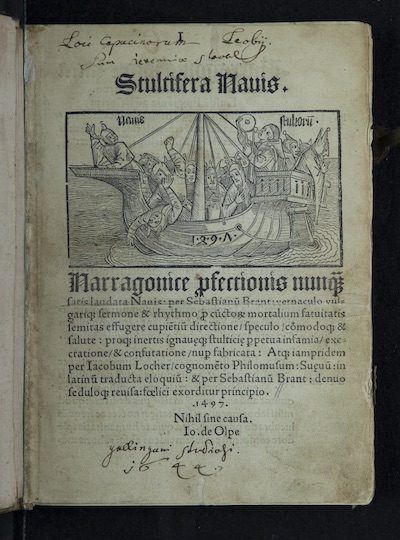
Figure 1. Woodcut image from Sebastian Brant, Narrenschiff.
Basel: Johann Bergmann von Olpe, 1497.
A1.B735nL
Satire and mockery fill the pages of this much cited and justly renowned work. The theme of the fool is pervasive, and shows in the use of fools caps on human figure throughout. The image of the Ship of Fools was a popular motif in the 15th and 16th centuries, though originally drawn from Plato’s Republic, and used to mock many aspects of perceived human folly.
↩
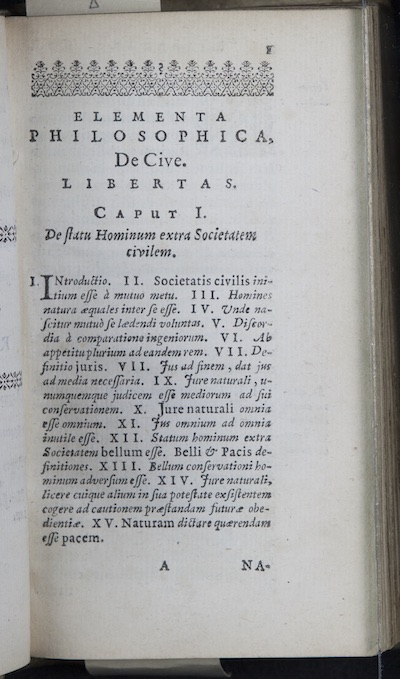
Figure 2.
Thomas Hobbes Elementa philosophica de cive. Amsterdam: Elzevir, 1647.
JC153 .H65deL
Thomas Hobbes’s highly influential work on “the citizen” was published in English translation in 1651 as Philosophical Rudiments Concerning Government and Society. The edition shown here was published in Amsterdam by the distinguished Elzevir Press, known for their pocket-sized books.
↩

Figure 3.
Theodor de Bry, Admiranda narration, fida tamen, de commodis et incolarum ritibus Virginiae, . Frankfurt: Johann Wechel, 1590.
*G159.B84a pt.1
This “Report of the New Found Land of Virginia” written by Thomas Hariot contains copperplate illustrations by Theodor de Bry (after original watercolors by John White). Though filled with cross-cultural mis-understandings and colonial projections, it is also a source of observations about the life of indigenous peoples cooking, fishing, and other activities of daily life and ritual.
↩
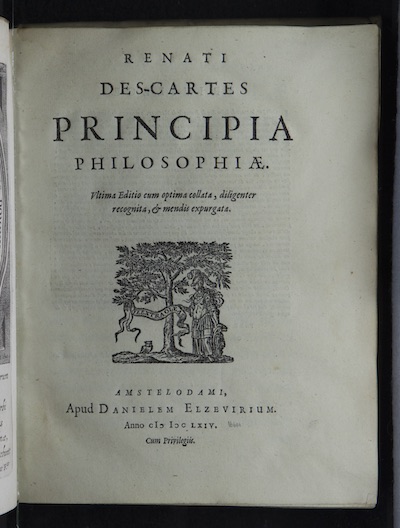
Figure 4.
Rene Descartes Opera Philosophica, . Amsterdam: Elzevir, 1664.
SCB 120955
René Descartes is one of the founding figures of rationalism. This book contains the “Discourse on Method of Rightly Conducting One’s Reason and Seeking Truth in the Sciences,” which is considered one of the crucial works in establishing a philosophical foundation for modern scientific method.
↩
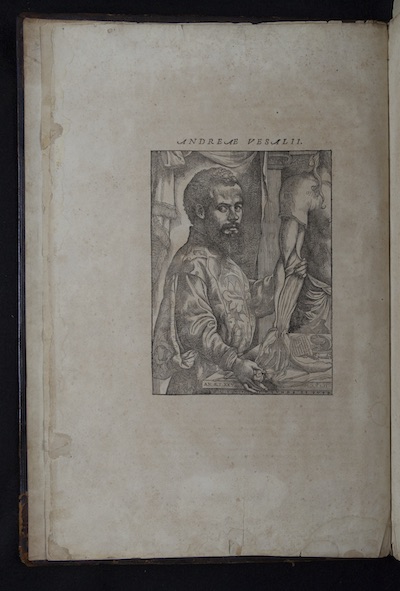
Figure 5.
Andreas Vesalius, De humani corporis fabrica. Basel: Ioannis Oporini, 1543.
** QM21 .V428 1543
The astonishing images in this anatomy text were produced from drawings by a student of the painter, Titian, Stephan Van Calcar. Even as they reveal their muscles, bones, and systems, they strike poses based on classical statues while being posed in elaborate landscapes or worldly settings.
↩
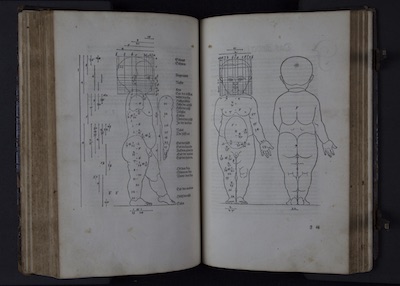
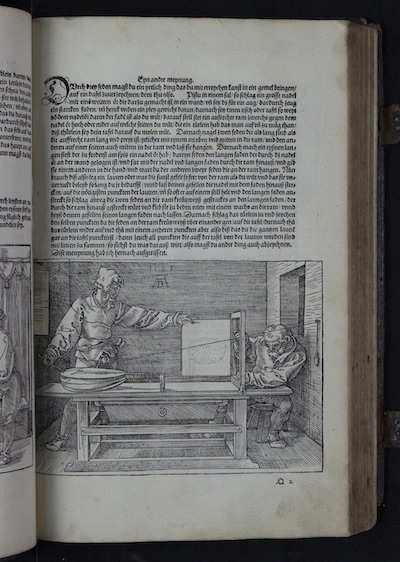
Figures 6a and 6b
Albrecht Dürer, Von menschlicher Proportion (On Human Proportion),. Nüremberg: 1528.
Belt *N6888.D8 A124 1527
The German painter, Albrecht Durer, was also a remarkable woodblock artist and his prints were widely reproduced in his lifetime and after, including the schemes for proportion and perspective that are found in this book.
↩
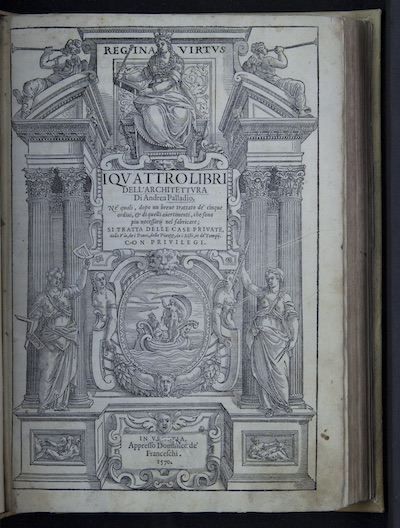
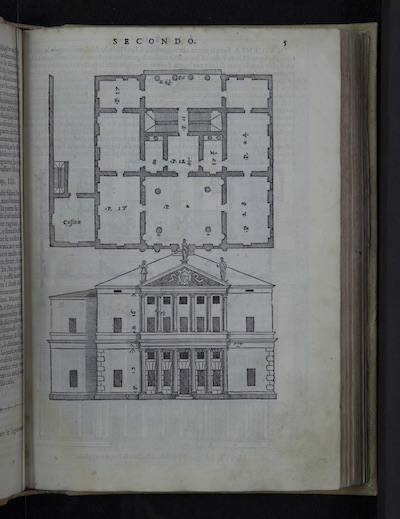
Figures 7a and 7b.
Andreas Palladi Four Books of Architecture, Venice: Domenico de Franceschi, 1570.
*NA2515.P17q
Palladio’s four books of architecture contain fundamental principles of design and proportion as well as suggestions for domestic and public buildings, and urban planning, expressed in more than 200 woodcuts. The organization of the layouts is made to support correlation of visual information.
↩
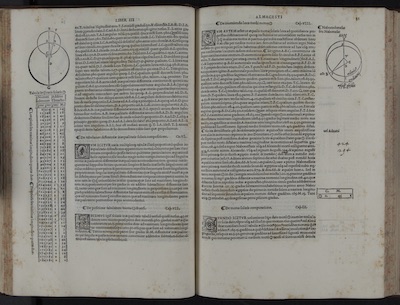
Figure 8.
Ptolemy, Epitome of the Almagest . Venice: Giunta, 1528.
C*Z233.G44 P959a 1528
This first edition of the first translations into Latin directly from the Greek original, (by George of Trebizond) made this major 2nd-century treatise by Ptolemy available to European astronomers. Note that the figures of the Sun and the Moon were cast into the font as characters. The tables required particular typographic virtuosity.
↩
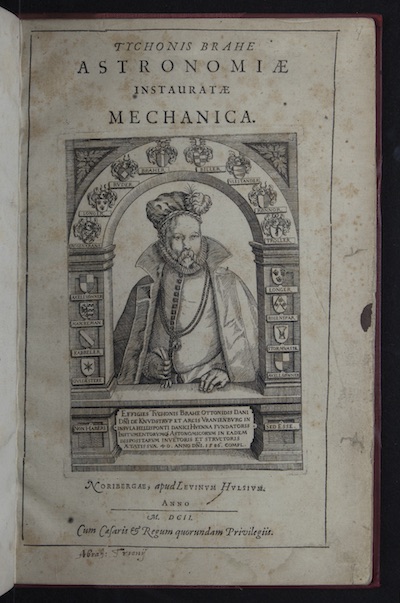
Figure 9.
Tycho Brahe, Astronomiae instaurata. The astronomer Tycho Brahe established his own print-shop in the same location as his observatory in order to publish his research and disseminate it, but this copy of his work was printed in Nuremberg.
↩

Figure 10.
Christopher Plantin, Index characterum anchitypographiae. Anvers: Musee Plantin-Moretus, 1905.
*Z250.P694i
A specimen book of many of the type fonts in the museum of the important Plantin Press in Antwerp. The ongoing value of these designs is evident in the lavish attention paid to this 20th century edition of 16th century printing materials.
↩

Figure 11.
Joseph Moxon, Mechanick Exercises, with preface and notes by Theodore De Vinne. New York, The Typothetae of the City of New York, 1896.
Theodore De Vinne; NY, The Typothetae of the City of New York, 1896.
Z244.A2 M87 1896 This late 19th-century book is a facsimile of the first edition published in the year 1683. The 17th-century original was a treatise containing information and advice on every aspect of the printing trades and practices. The book was illustrated throughout with engravings giving detailed visual instruction.
↩
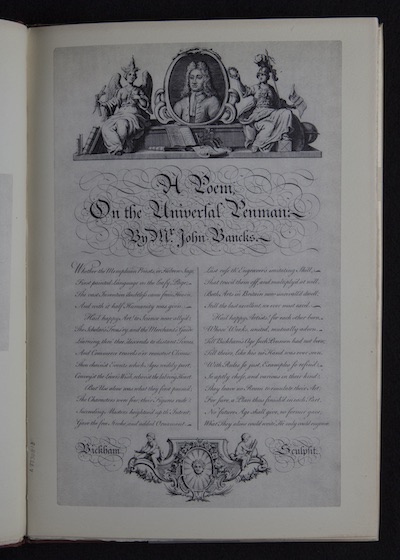
Figure 12.
George Bickham, The Universal Penman. Cambridge, UK: Chiswick Press for W. Heffer & Sons, Ltd., 1943.
Z43.B47 u1
Handwriting remained a crucial part of cultural practice after the invention of print. Writing was not only used to conduct business in every area of daily life, including public and private realms, but was also a display of taste and skill. The engraved plates that served as samples for copying were the result of extremely high levels of skill.
↩
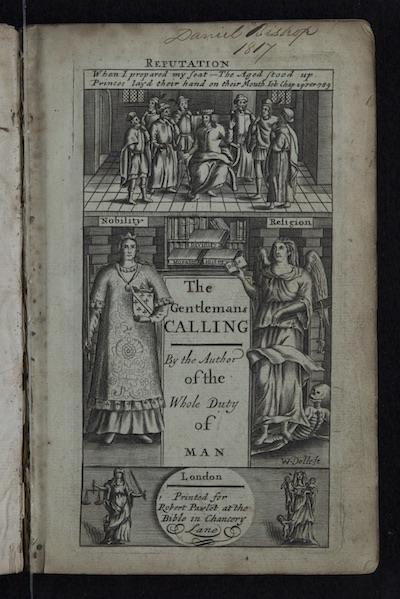
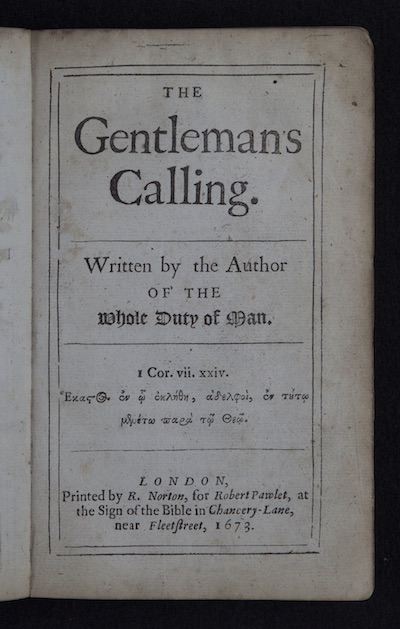
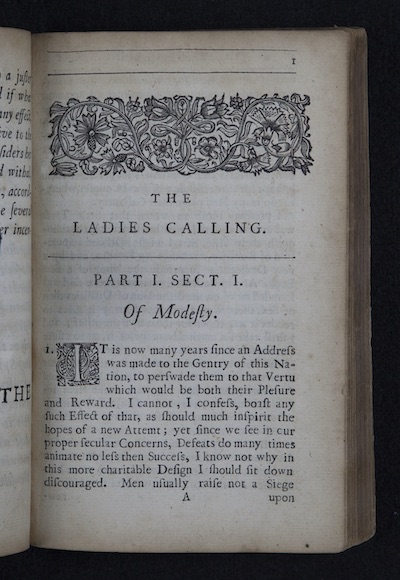
Figures 13a, 13b and 13c.
Richard Allestree, The Gentleman's Calling. The contrast in subjects deemed suitable for the training of men and women is striking. Men were clearly meant to manage their education, wealth, and authority, while women were to be instructed in matters such as modesty. The small scale and intimate format of these works show they were intended for individual use.
↩
All images are from books in the Charles E. Young Research Library at UCLA, unless otherwise noted.